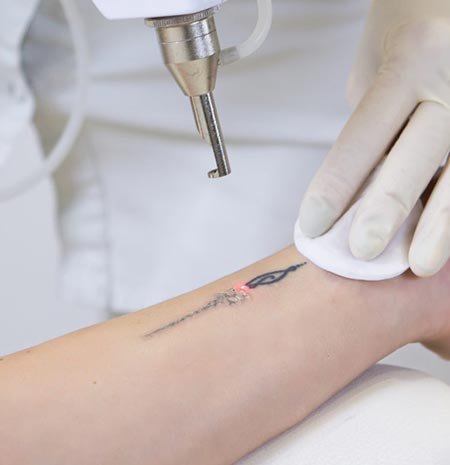Tattoos which are impulsively embedded in youth become a source of embarrassment in later years. Tattoos can be of various colours and appropriate handpieces are used to remove red, yellow and black pigment. It is the Q-Switch 532/ 1064 laser which is used for the procedure.
Post operative care will require dressings until original skin is restored.The advantage of this procedure, like in all previous lasers lies in its office based treatments which do not require expensive hospital admission.
The laser can remove professional, amateur (homemade), traumatic and surgical tattoos.
How many treatments will it take to remove a tattoo?
There are many factors that influence how quickly your tattoo can be removed:
- The amount of ink in the skin
- The type of ink that was used
- How old the tattoo is
- Whether it was an amateur or professional tattoo
- The depth of ink in your skin, and
- The color of the tattoo.

While it is impossible to predict the exact number of treatments necessary for removal, we can give you a best-guess estimate after the first treatment.
On the average, black and blue professional tattoos with an average amount of ink require 6-8 treatments, while amateur tattoos require 4-5 treatments, all spaced approximately 6-8 weeks apart. Darker skin types and densely pigmented tattoos may require many more treatments.
Some More Questions
Dark (blue, black) inks will resolve the best. Oranges and purples usually fade as well. Green and yellow inks are the most difficult to remove, and additional treatments are needed to produce significant fading. Other colors, such as flesh toned tattoos, white tattoos and glow-in-the-dark tattoos, are extremely difficult to remove.
In many cases, yes. Greater than 95% fading of the tattoo may be accomplished. However, it is important to know that there are more than 300 types of tattoo inks in use worldwide today, none of which are regulated by the FDA. Not knowing which tattoo ink was used, or how deeply it was applied, makes it impossible for the laser specialist to predict the degree of removal on any given tattoo.
Immediately after the procedure, the area may be a bit raised, swollen, and lighter in color. You will be asked to wear an ice pack for approximately 30 minutes. Some common post-procedure effects are: swelling, itching, blistering, scabbing, redness, hyperpigmentation (darkening of the area) and hypopigmentation (lightening).
All of these effects are generally transient and will resolve within a matter of days. If you have pigmentary alterations, it may take longer to resolve.
